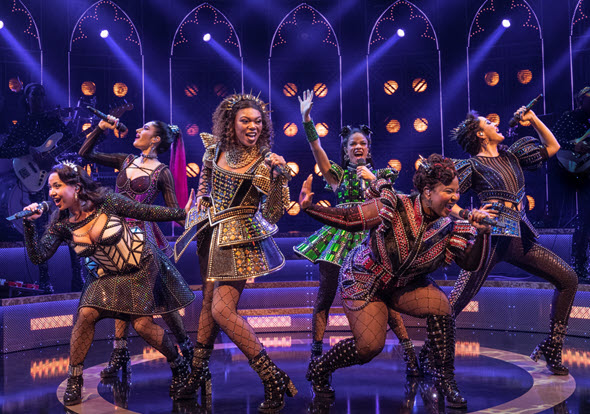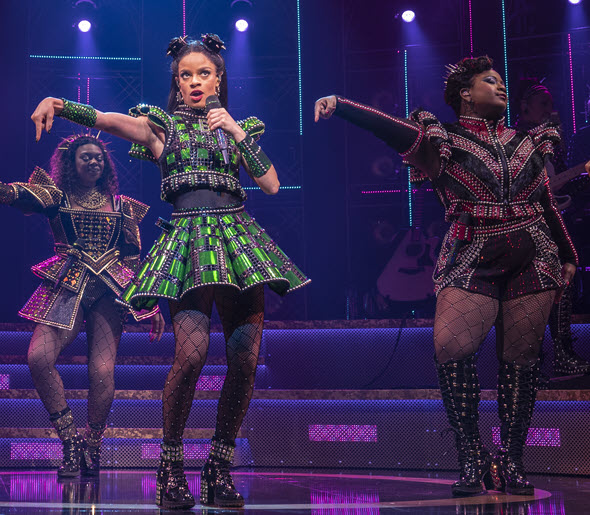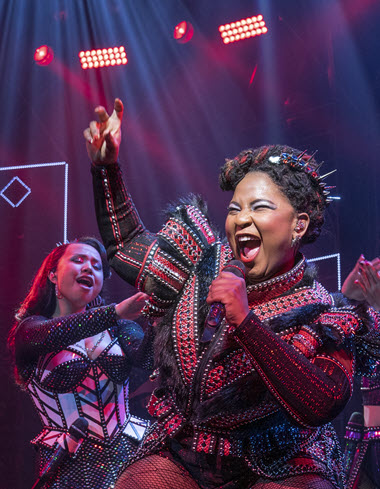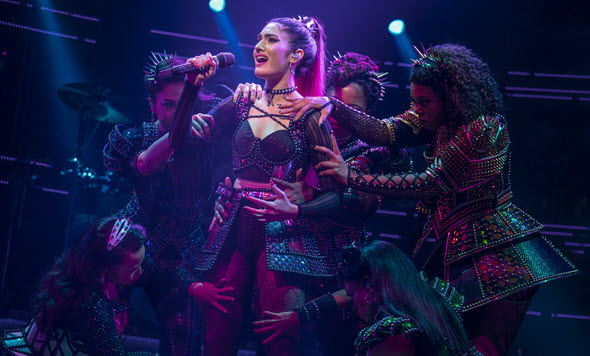Wives of Henry VIII reassess a bloody chapter in high-energy, smartly crafted musical ‘Six’
Review: “Six,” a musical by Toby Marlow and Lucy Moss, presented by Broadway in Chicago at the CIBC Theatre through July 3. ★★★★★
By Lawrence B. Johnson
A half-dozen descriptors leap to mind as I attempt to describe the musical “Six.” Supercharged, smart, funny, provocative, keen-edged, scintillating, seriously insightful. Oh, wait, that’s more than six. But then “Six” is more than the six characters – the wives of England’s 16th-century King Henry VIII – who give the show its title. It’s greater than the sum of its parts: an infectious show with a youthful vibe that even I, some decades beyond its target audience, would readily go back to enjoy again.
I knew I was on the “Six” market fringe when I approached the CIBC Theatre on opening night and saw all those young people in their glittering, Elizabethan-style garb. They knew why they were there. This was going to be a sort of Renaissance rock concert with a Sondheim-like twist — aggressive and in your face but also droll and sly. A shriek of delighted recognition split the air the moment the Six Queens hit the stage.
Though I had left my sparkly boots at home, I did bring along some knowledge of Elizabethan history and a familiarity with the six sundry women of diverse backgrounds whom Henry picked for wife after wife…after wife. I’d just like to say a word for the monarch. All the poor guy wanted was a male heir and some flexibility to move from mate to mate, or if you insist, from one pretty face to another. Viewed in a certain light, Henry, who was also a composer and wrote a bit of poetry, was merely expressing another facet of his natural creativity.
The point of “Six” is that his serial wives – divorced, beheaded, died, divorced, beheaded, survived – saw it quite differently. As did the Pope in Rome, who reminded the libidinous king that divorce was not a concept of the Catholic Church. Whereupon the ever-imaginative Henry divorced England from the Church in Rome and founded the Church of England with himself as its head. Now he could woo, wed or behead as the mood suited him. He was The One, which is significantly not the title of this show.
To summarize “Six” feels almost as silly as offering a precis of “Frozen.” Everyone knows it. Still, for the desperately unaware, I’ll be brief: The six Queens, wearing stylish period-inspired attire in which the actual wives might have felt rather drafty, come out as if to give a concert of rocking testimony to how much each suffered under the heavy yoke or simple neglect of the fickle Henry. At the end, the audience must decide who deserves the honor of Her Most Put-Upon Highness, or something like that. For the few who don’t know how it all works out, I am loath to act as a spoiler.
First of the Queens to strut her stuff – time-traveled modernists all – is indeed Henry’s first mate, Catherine of Aragon (Khaila Wilcoxon), who laments that her wifely devotion to Henry was repaid by his mooning after pretty Anne Boleyn, whom he would next marry. It was for Anne that Henry threw off the entire Catholic Church, only to make her the first he would consign to the headsman’s ax. Still, before her exit, Anne gave birth to the future Elizabeth I. In one of the show’s funniest numbers, Anne Boleyn (Storm Lever) rethinks how flirting with other guys to make the king jealous and maybe win him back was not – how shall I put this – a capital idea.
By all accounts, Henry’s third wife, Jane Seymour, was the one for whom he had the greatest affection, even if his fondness was tempered by his expectation that she would provide him with a male heir. She died in childbirth. When the other wives mock Jane (Jasmine Forsberg) as the one who had it the easiest, she replies with a chilling narrative of Henry’s stony heart and the emptiness of their marriage. The most sadly amusing story is sung by Olivia Donalson as Anna of Cleves, Henry’s German-born fourth wife, whom he agreed to wed having seen only her portrait. When the image proved to be extremely flattering, Henry relegated her to a life of boundless wealth in a grand palace, but without his attention. And thus she lived and died.
Possibly the show’s best number, and most brilliant performance of the night, is that of Katherine Howard (Didi Romero), a great beauty who was only 17 when Henry married her. Two childless years later, she became the matrimonial headsman’s second victim. The other Queens dismiss Katherine as irrelevant, but in perceptive lyrics offered with compelling expression, Romero observed the irony of a beauty that turned men’s heads but never brought comfort to her soul. Arguably the most heartbreaking tale is that of Henry’s sixth and last wife, Catherine Parr (Gabriela Carrillo). Henry plucked her from the arms of her true love, Thomas Seymour, when she was 31. But shortly after Henry’s death, she married Seymour — only to die in childbirth.
Yet Catherine Parr, as Carrillo’s song reminds us, was not one to sit around feeling sorry for herself. She was a doer, and among the things she did was to become the first woman in England to publish a book under her own name. Catherine’s spirited song inspires a collective alteration in the Queens, who take up a feminist anthem to the effect that none of them should be defined forever by the whims of a king. They are individuals, people with their own self-determination, etc., etc. I’m not entirely sold on the rally-round-the-feminist-flag ending, which doesn’t measure up to the wit or the original thinking of all that comes before.
“Six” takes tremendous energy and a fine edge from a four-piece onstage band – keyboards, lead guitar, bass guitar and drums (all played by women) – and intricately punctuating choreography by Carrie-Anne Ingrouille. Emma Bailey’s arching, stylized Elizabethan set design and Tim Deiling’s clever lighting top off a touring show that has the look at feel of the B’way in NY City. It’s a heady, seductive, wholly engaging night of musical theater.
Related Link:
- Performance location, dates and times: Details at TheatreInChicago.com








